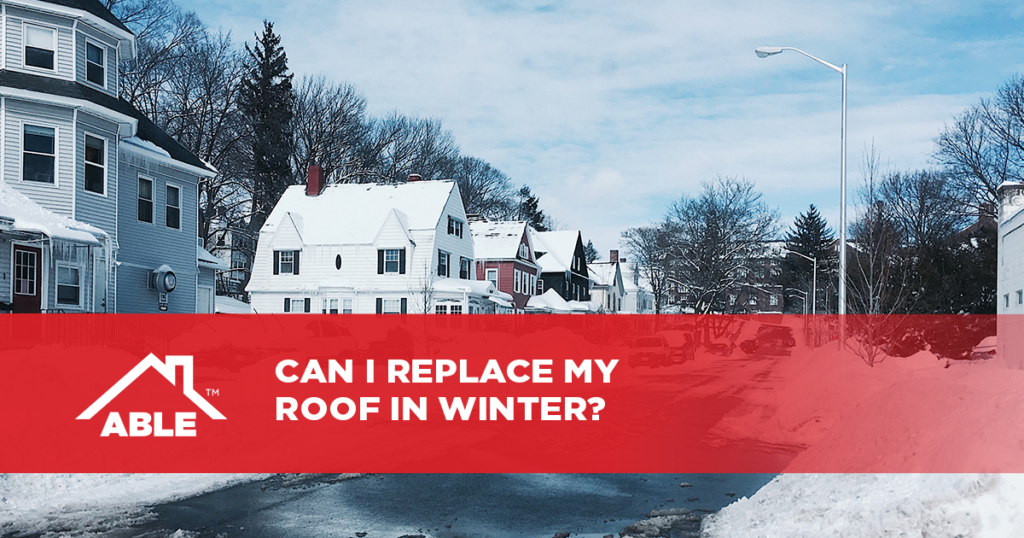Winter can wreak havoc on roofs. Constant temperature fluctuation or massive snowfalls put a lot of pressure on roof performance. Noticing issues with your roof in the middle of winter can be alarming and give you cause for concern. Ultimately, while replacements can be installed in the middle of winter, there are other factors that can impact the process more than during warmer times of the year.
Why won’t all contractors complete winter replacements?
Replacing roofs is a dangerous job, but the addition of winter elements creates even more obstacles. Freezing temperatures can cause ice dams to form, which could be difficult to see in some areas. Collected snowfall can create extra slippery surfaces and hide damage or weak areas in a roof. Because of these elements, there are some contractors who avoid roof work in the winter.
Roofing materials in winter
The roofing process contains many different materials to create a lasting, protective roof for any home. Depending on your roof, the physical materials may be difficult to work with in winter. Shingles, for example, are one of the most common types of roof. However, they are best installed above 40 degrees. When installed below this temperature, they run a greater risk of cracking or becoming damaged. However, newer upgrades to shingle mats –the surface that holds the shingles together – have made it possible to install them below 40 degrees.
If the shingles used by a roofing contractor are self-adhesive, then colder temperatures may also impact the successful installation of the new roof. The cold weather affects the adhesive and may cause it not to adhere properly. This would only cause more problems later. Other roofing materials, such as those used for installing a metal roof, do not face the same temperature impacts as shingles, making metal roof replacements in winter more successful.
Replacing a roof in winter may take longer
One of the biggest obstacles facing roofers during the winter months is the availability of workers. Because winter often sees a decline in the amount of work available, the resulting impact is workers who may look for winter jobs that are more consistent. Smaller crews mean fewer hands on the project, so the work may move more slowly.
There is also a dependency on the weather for both the right conditions and the power of the sun. Roofing work needs to be completed when it is dry. Installing a roof in the snow or rain is not going to provide the quality or consistency that you want from something new. You may find additional problems present themselves not long after installation.
Even if it is dry, that is not to say it is warm. As mentioned, there are ideal temperatures at which roofing materials need to be to successfully do their job. When roofers are installing shingles below 40 degrees, they will want to warm them in order to keep them pliable. This process can look different, but all of it may cost additional time during the installation process. A couple of commonly used strategies are:
- If the temperature is below 40 degrees, but it is sunny, the shingles can be spread out on the roof to absorb not only the sun’s energy but any heat that may arise from the heat in the home as well.
- The shingles may be stored in a garage or attic prior to installation to protect them from the temperatures and keep them at a more consistent temperature.
Benefits to roof installation in winter
Although there are obstacles that can make winter roof installation difficult, there are benefits to choosing this time of year. Because the industry is typically slower during winter months, material costs may decrease, saving you money.
Not only is there potential cost saving from the material but from your home as well. Proper roofing can help to keep energy costs down. Leaks or gaps in the roof leave areas for heat and cold to escape and enter, causing your heating system to work overtime.
Replacing your roof in winter
Working on the exterior of a home seems out of place in the winter, but it can often be the best time of year. If replacing a roof is an obstacle you are facing in the winter, make sure to do your homework and find a contractor that has a proven record of proper winter installation. It is completely ok and encouraged to ask questions about the process or to see previous projects a company has done.
At Able Roofing, we understand the challenges of Winter installation. Whether you are facing the lake effect snow of Michigan, the mountains of Tennessee and North Carolina, or you’re in the Ohio River Valley, our professionals have the expertise and the experience to help you stay warm and dry this winter. Call our offices today for a free estimate.








